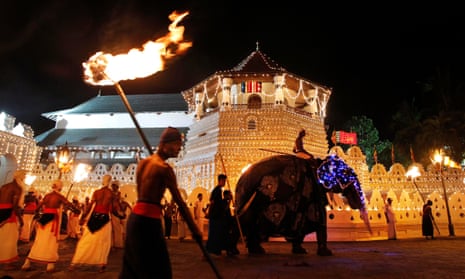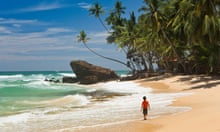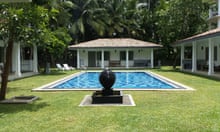On a hill directly above Kandy there is a statue of Buddha in a seated posture, palms on his lap, signifying meditation. This is far from the most important shrine in this Buddhist-majority city, or indeed an unusual sight in Sri Lanka – the country is peppered with polished white or golden statues that are visible from afar, distinctive amid vegetation. Nonetheless, its proximity to Kandy makes it a good point from which to contemplate the city – and a highly Instagrammable one.
On a scorching spring afternoon, western tourists snapped photos under the indifferent eye of Buddhist monks, while one could hear distant religious chants mixed with the sounds of 90s European dance hits at a party – a scene that pretty much represents the vertiginous change happening in Sri Lanka which, less than a decade after the traumatic civil war ended, is experiencing a tourism boom.
The Buddha’s tooth
Right at the heart of the island, Kandy is the second largest city in the country after the capital, Colombo, but feels like a small town. The city officially has a population of around 125,000, according to the latest registered census in 2012, but the number has probably increased greatly. Spread out around a lake and surrounded by mountains, it is a historically significant city and arguably the country’s cultural capital: its spectacular Temple of the Sacred Tooth Relic, in which is enshrined a tooth of the Buddha – the country’s most important Buddhist relic.
The tooth is precisely the reason for the 10-day elaborate multi-procession festival happening in the city this week, Kandy’s Esala Perahera, in which a replica of the relic is paraded around the city. After six relatively modest days, proceedings escalate on the last four, culminating on the night of the poya (full moon) with thousands of Kandyan dancers and drummers, dozens of elephants dressed trunk-to-toe, colourful banners and more, in Kandy’s biggest night of the year and Sri Lanka’s most striking celebration.
The city in numbers …
500 - altitude in metres; referred to as the “hill capital,” it is itself surrounded by mountains and by the country’s extensive tea plantations.
1815 - year the last Sinhalese kingdom, of which Kandy was capital, fell to the British (after resisting the Dutch and the Portuguese for three centuries).
50 - approximate number of elephants that parade during the Esala Perahera. The number has been as high as 100.
… and pictures
This article includes content provided by Instagram. We ask for your permission before anything is loaded, as they may be using cookies and other technologies. To view this content, click 'Allow and continue'.
This article includes content provided by Instagram. We ask for your permission before anything is loaded, as they may be using cookies and other technologies. To view this content, click 'Allow and continue'.
This article includes content provided by Instagram. We ask for your permission before anything is loaded, as they may be using cookies and other technologies. To view this content, click 'Allow and continue'.
This article includes content provided by Instagram. We ask for your permission before anything is loaded, as they may be using cookies and other technologies. To view this content, click 'Allow and continue'.
Kandy in sound and vision
Kandy’s most memorable cinematic appearance is on Indiana Jones and the Temple of Doom. After the Indian government reportedly found the script offensive – not without reason – the location was switched to Kandy (and England). The fictional Mayapore village, theoretically in North India, was actually filmed in a government-owned tea plantation three miles from the city, and the infamous rope bridge was built and destroyed on the nearby Victoria Dam.
History in 100 words
Kandy dates back to the early 13th century, when the ancient kingdom of Polonnaruwa collapsed and the Sinhalese people moved south. When the rest of the island fell to the Portuguese in 1505 (and, later, the Dutch), the Kingdom of Kandy maintained its grasp on independence, protected by its location in the steep hills in the middle of the country. It wouldn’t lose it until the British invaded in 1815. This isolation gave it an inward-looking, conservative character it preserves to this day.
The same inaccessibility largely protected it from suffering during Sri Lanka’s civil war. Unlike Colombo, Kandy only suffered one significant LLTE attack, a bomb outside the Temple of the Tooth which killed 17 people. Modern Kandy has continued to grow, with urbanisation sprawling up the surrounding hills, especially after the civil war ended and tourism skyrocketed.
What’s everyone talking about?
The Buddhist festival is monopolising attention this week, but more generally, Kandyans are concerned about urbanisation, which is visibly spreading in the surrounding hills, and the resulting congestion and pollution. Kumar Lopez, CEO at the Sri Lankan press institute, says the city’s daily life and even the environment have “drastically changed” since the tourism boom started. “The cool breeze Kandy was known for is gone, and the city has become humid like Colombo.”
For now, tourism seems to be regarded as an opportunity, with hotels and small businesses popping up all over town. People are also talking about the country’s dengue outbreak. Tanya Perera, who runs a B&B in the city, says this has been a unanimous concern among guests.
What’s next for the city?
The government is building a 115km four-lane highway between Kandy and Colombo, which is expected to cut the driving time from its current 3-4 hours. Its 200 billion rupees (£1bn) cost has been part-funded privately, with Chinese assistance. Many in the region hope the road will revitalise the entire central area of the country and give Kandy a true “second city” status.
Close zoom
Travellanka is a complete online guide to the city, but you’re better off chatting to locals if you want to get under the skin of the city. National newspapers include the Sunday Times and the Sunday Observer.
Do you live in Kandy? What have we missed? Tell us below or follow Guardian Cities on Twitter and Facebook to join the discussion, and explore our archive here








Comments (…)
Sign in or create your Guardian account to join the discussion